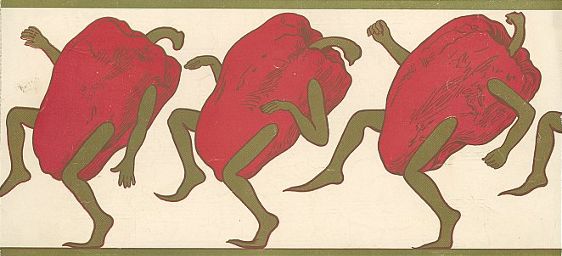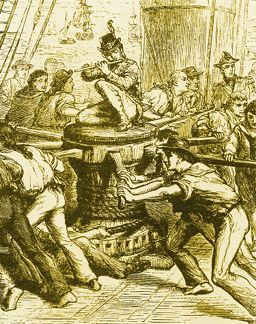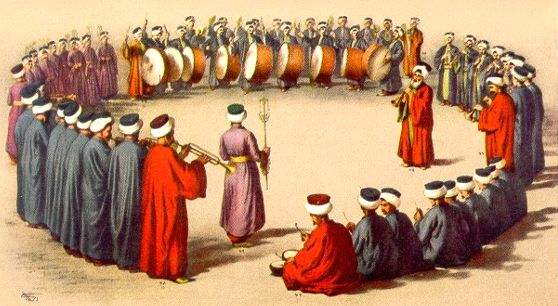Wednesday 1 July 2009
from Devienne's Flute Concerto No. 2 in D major
Upon a request by Amanda, one of our kind followers, today we present a full transcription of the third movement of Devienne's Flute Concerto No. 2. It is a Rondo, to be played in the form ABABCA. We inserted some measures from the oboe and the violin parts, so that the whole piece can now be played on just one instrument. In order to distinguish them, these insertions have been engraved in small notes.
And now for some words on the Composer. François Devienne was an 18th-century French composer and professor of flute at the Paris Conservatory. His compositions for flute, revived by Jean-Pierre Rampal in the 1960s, are now better known to flutists, but still not, unfortunately, to the public at large.
Devienne’s concertos are actually quite remarkable, and Concerto No. 2 in particular is an admirable example of grace and balance, reflecting the elegance and brilliance of classical music in Paris at the time. All these qualities earned Devienne the title “the French Mozart”.
Thursday 2 July 2009
A Spicy Rag by Henry Lodge

Published in 1910, “Red Pepper” is indeed a spicy rag well in keeping with the jolly cakewalking red peppers as illustrated on the front cover of the original sheet music.
Its composer was Thomas Henry Lodge (now better known as Henry Lodge), an American piano performer and composer of popular music. With the hits “Temptation Rag”, “Sure Fire Rag” and “Red Pepper” he established himself selling music in stores and on the vaudeville circuit. He worked in bars and cabarets before eventually becoming the pianist of the well-known dancers, Irene and Vernon Castle. In all his work, Lodge was fascinated with the minor tonality, and made more creative use of it than any other ragtime composer.
Friday 3 July 2009
Traditional Irish jig
Here's another jig which has become a somewhat popular session tune in Ireland and Australia. The title means that someone named Willie Coleman played it, but not necessarily that he composed it.
Saturday 4 July 2009
from Robert Schumann's “Kinderszenen”
Kinderszenen (“Scenes from Childhood”), Op. 15, is a set of thirteen pieces of music for piano written in 1838 by German composer Robert Schumann. In this work, the great romantic Pianist provides us with his adult reminiscences of childhood. Schumann had originally labeled this work Leichte Stücke (“Easy Pieces”). Likewise, the section titles were only added after the completion of the music, and Schumann described the titles as “nothing more than delicate hints for execution and interpretation”.
“Träumerei” is one of Schumann's best known pieces. It was even used as the title of a 1944 German biopic on Robert Schumann. “Träumerei” is also the love song for Robert and Clara Schumann in the 1947 Hollywood film Song of Love, starring Katharine Hepburn as Clara Wieck Schumann.
Sunday 5 July 2009
Traditional English song
This tune was known in both England and Scotland. It is also known in the Appalachians. It was used in some areas as a two team singing game.
O Madam, I will give you
The keys of Canterbury,
And all the bells in London
Shall ring to make us merry.
If you will be my joy, my sweet and only dear,
And walk along with me, anywhere.
I shall not, Sir, accept of you
The keys of Canterbury,
Nor all the bells in London,
Shall ring to make us merry.
I will not be your joy, your sweet and only dear,
Nor walk along with you, anywhere.
Other variants and alternate titles include: “The Keys of Heaven”, “Madam I Present You with Six Rows of Pins”, “The Disdainful Lady”, “There Stands a Lady on the Mountain”, “There Stands a Lady in the Ocean”, “When I Was Young I Was Well Beloved”, “If You Will Walk With Me”, “Oh Madam I Will Give to Thee”, “Blue Muslin” and “The Little Row of Pins”.
Monday 6 July 2009
Theme from “L'apprenti sorcier” by Paul Dukas

“The Sorcerer's Apprentice” (original French title “L'apprenti sorcier”) is a symphonic poem composed by Paul Dukas in 1897. It was inspired by Goethe's 1797 poem of the same name (“Der Zauberlehrling” in German).
Although Dukas's musical piece, first published in 1897, was already quite well known and popular, it was made particularly famous by its inclusion in the 1940 Walt Disney animated film Fantasia, in which Mickey Mouse plays the role of the apprentice. The popularity of the musical piece in Fantasia caused it to be used again in Fantasia 2000.
Perhaps the best-known Mickey Mouse short after Steamboat Willy, The Sorcerer's Apprentice tells the story of Goethe's famous poem, which is a story of wizard's meek assistant who attempts to work some of the magical feats of his master, before he knows how to properly control them.
Interestingly, the sorcerer's anger with his apprentice, which appears in Fantasia, does not appear in the Goethe source poem
Tuesday 7 July 2009
from Tchaikovsky's “Album for the Young”
Today we propose a transcription for flute and piano of “Morning Prayer”, the very first composition in Pyotr Ilyich Tchaikovsky's Album for the Young, Op. 39.
Wednesday 8 July 2009
American folk song

This enchanting song seems to have originated in the early nineteenth century as a land ballad in the areas of the Mississippi and Missouri Rivers, with a story of a trader who fell in love with the daughter of the Indian chief Shenandoah. The song was taken up by sailors plying these rivers, and thus made its way down the Mississippi to the open ocean. The song had great appeal for American deep-sea sailors, and its rolling melody made it ideal as a capstan shanty, where a group of sailors push the massive capstan bars around and around in order to lift the heavy anchor.
The song reached its first height of popularity perhaps a little before the 1840s, the beginning of the fast clipper ship era that added so much to American growth. The song was traditional with the U.S. Army cavalry, who called it “The Wild Mizzourye”.
In fact, “Shenandoah” was known by countless names, including: “Shennydore”, “The Wide Missouri”, “The Wild Mizzourye”, “The Oceanida” and “Rolling River”.
Thursday 9 July 2009
by Felix Mendelssohn-Bartholdy
This is probably the best known of Mendelssohn's 100 or so songs.
Mendelssohn wrote the piece a couple of months after moving to Leipzig to become director of the Gewandhaus Orchestra and Singakademie. He had just spent a frustrating two years in Düsseldorf trying to conduct somewhat amateur musicians and performing for unappreciative audiences. He found that everything in cosmopolitan, cultured Leipzig was to his liking; his contentment is reflected in this song.
With this song Mendelssohn set to music a German romantic poem by Heinrich Heine. The text tells of melody's power to transport lovers to the most beautiful night garden, with bright and fragrant flowers, gazelles, a murmuring stream, and a palm tree, under which they can dream.
Friday 10 July 2009
Flute solo by Arthur Honegger

Literally, “Dance of the Goat”. This curious piece for solo flute is meant to illustrate a goat dancing on a grassy hill after the winter snows have melted away. It was written in 1921 by Swiss composer Arthur Honegger as incidental music for dancer Lysana of Sacha Derek's play La Mauvaise Pensée. However, the original manuscript of this piece has been lost. The editions that are out now were derived from a partial transcript found in Honegger's transcriptionist's works. The piece has been worked on by historians to be as accurate as possible.
The piece starts with a slow dreamlike introduction consisting of tritone phrases. This soon unwinds into the “goat-like” theme in a chromatically altered F major in 9/8 that skips along providing the lively picture of a dancing goat. Following this theme is a lighter songful melody, which brings a more calm feeling and leads to the reiteration of the initial dreamlike idea. The piece finally ends on a soft, fading C for resolution.
Saturday 11 July 2009
Traditional American lullaby

This traditional lullaby, which many children simply know by the first three words of the lyrics — "Hush a bye" —, comes from the southern United States.
As the story goes, the song was originally sung by an African American slave who couldn't care for her own baby because she was kept busy caring for her master's child.
However, as the song was transmitted by oral tradition, not much is definitively known about it.
Sunday 12 July 2009
from Mozart's Piano Sonata No. 11

This last movement of Mozart's Sonata No. 11, called “Alla Turca”, is popularly known as the “Turkish March”, although this name more correctly refers to another piece by Beethoven.
It is often heard on its own and is one of Mozart's best-known piano pieces. It imitates the sound of Turkish Janissary bands, the music of which was much in vogue at that time. Various other works of the time imitate this music, including Mozart's own opera The Abduction from the Seraglio.
Monday 13 July 2009
Shaker dance song by Elder Joseph Brackett
This song was largely unknown outside of Shaker communities until it became world famous thanks to its use in Aaron Copland's score for Martha Graham's ballet, Appalachian Spring, first performed in 1944. Copland used “Simple Gifts” a second time in 1950 in his first set of Old American Songs for voice and piano, which was later orchestrated. Many people thought that the tune of “Simple Gifts” was a traditional Celtic one but both the music and original lyrics are actually the compositions of Brackett.
The song has since endured many inaccurate descriptions. Though often classified as an anonymous Shaker hymn or as a work song, it is better classified as a dance song, as the references to “turning” in the lyrics testify.
Tuesday 14 July 2009
from “The Tale of Tsar Saltan” by Nikolai Rimsky-Korsakov

This famous orchestral interlude was written by Nikolai Rimsky-Korsakov for his opera The Tale of Tsar Saltan, composed in 1899–1900. The piece closes Act III, Tableau 1, during which the magic Swan-Bird changes Prince Gvidon Saltanovich (the Tsar's son) into an insect so that he can fly away to visit his father, who does not know that he is alive. Although in the opera the Swan-Bird sings during the first part of the “Flight”, her vocal line is melodically uninvolved and easily omitted; this feature, combined with the fact that the number decisively closes the scene, made easy extraction as an orchestral concert piece possible.
“Flight of the Bumblebee” is recognizable for its frantic pace when played up to tempo, with nearly uninterrupted runs of chromatic sixteenth notes. It is not so much the pitch or range of the notes that are played that challenges the musician, but simply the musician's ability to move to them quickly enough.
Although the original orchestral version mercifully assigns portions of the sixteenth-note runs to various instruments in tandem, in the century since its composition the piece has become a standard showcase for solo instrumental virtuosity, whether on the original violin or on practically any other melodic instrument.
Wednesday 15 July 2009
Traditional nursery rhyme
Probably of French origin, this tune is, by some, attributed to Jean-Jacques Rousseau, to whom it is said to have come in a dream.
This nursery jingle eventually became the universal lullaby of the pioneers and has been found in every part of america as “Aunt Tabby”, “Aunt Sarah”, “Aunt Nancy”, “Aunt Dinah”, “Aunt Susie”. It is also known as “The Old Grey Goose”.
Thursday 16 July 2009
Flute duet: Felix Mendelssohn's “Hochzeitsmarsch”
This is certainly the best-known of the pieces from the suite of incidental music for Shakespeare's play A Midsummer Night's Dream, written by Mendelssohn in 1842. It is one of the most frequently used wedding marches, generally being played on a church pipe organ.
At weddings in many English-speaking countries, this piece is commonly used as a recessional, though frequently stripped of its episodes in this context. It is frequently teamed with the “Bridal Chorus” from Richard Wagner's opera Lohengrin, or with Jeremiah Clarke's “Prince of Denmark's March”, both of which are often played for the entry of the bride.
The piece apparently became popular at weddings when it was selected by Victoria, Princess Royal (the eldest child of Queen Victoria of the United Kingdom) for her marriage to Prince Frederick William of Prussia in 1858.
Friday 17 July 2009
Easy traditional German folk song
This song probably originated during the 19th century in Germany, where it is known under the name of “Hänschen klein”, or “Alles neu macht der Mai”.
Originally it told of a boy (‛Little Hans’) who ventures to the world and returns as a man to his family. It gained much more popularity around 1900, when it came to be adopted as the very first song to be taught to small children, whether at home or in kindergarten. Now it is about a boy who is going away but returns immediately, since his mother, left alone, began crying. Other countries have written new lyrics for the tune. In the United States, the song is about a family rowing a boat and having a happy time.
It is the theme song of the 1977 war film Cross of Iron with James Coburn.
Saturday 18 July 2009
from Piano Sonata No. 2 in B-flat minor by Frédéric Chopin
This third movement begins and ends with the celebrated funeral march in B flat minor which gives the piano sonata its nickname, but has a calm interlude in D flat major. While the term “funeral march” is perhaps a fitting description of the whole movement, complete with the interlude, “Chopin's Funeral March” is used commonly to describe only the part in B flat minor.
The piece has become well known in popular culture. It was played at the graveside during Chopin's own burial at Père Lachaise cemetery in Paris. It was also used at the state funerals of John F. Kennedy and those of Soviet leaders, including Leonid Brezhnev. It was transcribed for full orchestra by English composer Sir Edward Elgar in 1933 and its first performance was at his own memorial concert the next year.
Sunday 19 July 2009
Flute duet by Andreas Romberg
Answering a request made yesterday by one of our followers, today we propose a rather advanced duet.
Although its composer was a violinist, this duet was specifically written for two flutes. In fact, besides symphonies, string quartets and no less than 20 violin concertos the German Andreas Romberg created numerous chamber music works for different instrumentations.
Monday 20 July 2009
Traditional Canadian folk song
This popular Canadian children's song is about plucking the feathers off a skylark, a small bird. It originated with the French Canadian fur trade.
Although it is in French, it is well-known among speakers of other languages. Many American soldiers learned the song while serving in France during World War I and brought it home with them.
Tuesday 21 July 2009
Celebrating 40 years since man landed on the Moon.

Also sprach Zarathustra, Op. 30 (in English “Thus Spoke Zarathustra”) is a symphonic poem by Richard Strauss, composed in 1896 and inspired by Friedrich Nietzsche's philosophical treatise of the same name.
Its introduction, which we are proposing today in an arrangement for flute and organ, has become well-known owing to its use as the key musical motif in Stanley Kubrick's 1968 film 2001: A Space Odyssey.
Wednesday 22 July 2009
Traditional Irish jig
Also known as “Lillibullero” or “Lilliburilero”, this is one of the best-known Irish tunes of all time. It started life as a jig with Irish roots, whose first appearance seems to be in a collection published in London in 1661, where it is set to the words “There was an old man of Waltham Cross”. It was arranged for polite society by the English composer Henry Purcell in 1689, and has been published in his keyboard work Musick's Handmaid. It is probable that Purcell hijacked the tune as his own, a common practice in the musical world of the time.
In 1687, however, the tune was set to different words, at a time when the Roman Catholic King James II was becoming increasingly unpopular. In this guise, the song was subsequently adopted by William of Orange as a marching tune for his Protestant troops.
A French version of the tune is also known as the “Marche du Prince d'Orange”, attributed to Louis XIV's court composers Philidor the Elder and Jean-Baptiste Lully.
The song's title and the words of the refrain have been interpreted as a garbled version of the Irish words Lile ba léir é, ba linn an lá, “Lilly was clear and ours was the day”. The lily may be a reference to the symbol of France, or to a popular interpreter of prophecies named William Lilly, who had prophesied in the late 16th century that a Catholic would come to the throne of England. Alternatively, the lyrics could mean, “Lilly is clear [about this], the day will be ours”. It is also thought that “Lilli” is a familiar form of William, and that “bullero” comes from the Irish Buaill Léir ó, which gives: “William defeated all that remained”
Lilliburlero's military association was rekindled in the Second World War, when it was played on the BBC Home Service programme Into Battle in 1943, and as a result was chosen as the regimental march for the Royal Electrical and Mechanical Engineers (REME).
Thursday 23 July 2009
from “The Well-Tempered Clavier” by J.S. Bach
The Well-Tempered Clavier (Das Wohltemperierte Klavier in the original German) is a collection of solo keyboard music composed by Johann Sebastian Bach. Dated 1722, it contains preludes and fugues in all 24 major and minor keys, dated 1722. It was composed “for the profit and use of musical youth desirous of learning, and especially for the pastime of those already skilled in this study”.
The best-known piece from the book is the very first prelude, a simple progression of arpeggiated chords. The technical simplicity of this C major prelude has made it one of the most commonly studied piano pieces for students completing their introductory training. Transcribed for the flute, it makes an excellent lip flexibility exercise.
This prelude also served as the basis for the Ave Maria of Charles Gounod.
Friday 24 July 2009
from Concerto No. 3 “Il Gardellino” by Antonio Vivaldi
The Opus 10 concertos constitute the most significant repertoire that Vivaldi composed for flute.
In Concerto No. 3 in D major, RV 428, the Italian composer demonstrates his perfect understanding of the instrument, writing trills, leaps, rapid florid passages, repeated notes, dotted rhythms, all of which evoke the warblings of a real goldfinch (a “gardellino” in Italian).
Today we present the second movement from this concerto, marked Cantabile (‛singable’). It features the flute in a beautiful cantilena in siciliano rhythm over a rocking accompaniment.
Saturday 25 July 2009
Traditional Australian folk song

“Waltzing Matilda” is Australia's most widely known folk song, and has been referred to as “the unofficial national anthem of Australia”. The title is Australian slang for travelling by foot with one's goods in a “Matilda” (bag) slung over one's back.
The song narrates the story of an itinerant worker making a drink of tea at a bush camp and stealing a sheep to eat. When the sheep's owner arrives with three police officers to arrest the worker for the theft (a crime punishable by hanging), the worker drowns himself in a small watering hole and goes on to haunt the site.
The song has never been the officially recognized national anthem in Australia. Unofficially, however, it is often used in similar circumstances. The song was one of four included in a national plebiscite to choose Australia's national song held in 1977 to determine which song was preferred as Australia's national anthem. “Waltzing Matilda” received 28% of the votes, compared with 43% for “Advance Australia Fair”.
The song has also gained popularity as a sporting anthem for the Australia national rugby union team, as a response to the New Zealand All Blacks haka.
Sunday 26 July 2009
from Debussy's “Children's Corner”, arranged for flute quartet
Children's Corner is a suite for solo piano by Claude Debussy, completed in 1908. It is dedicated to Debussy's daughter, Claude-Emma (known as “Chou-Chou”), who was three years old at the time. The pieces are not intended to be played by children; rather they are meant to be evocative of childhood.
There are six pieces in the suite, each with an English-language title, a choice reflecting Debussy's anglophilia.
The last piece, “Golliwogg's Cakewalk”, is the most rhythmic piece of the collection, inspired by the lively Afro-American cakewalk dance. Debussy imagined it being danced by Golliwogg (aka Golliwog), a character of children's literature, inspired by a blackface minstrel doll.
The middle section of this cakewalk is jokingly interrupted on several occasions by quotations of the opening of Richard Wagner's opera Tristan und Isolde, marked avec une grande émotion (“with great feeling”). Each quotation is followed by a sort of musical chuckle in staccato chords.
Monday 27 July 2009
English folk song by King Henry VIII of England
Also known as “The King's Ballad”, this folk song was written by King Henry VIII in the first years of the 16th century, shortly after being crowned. It is regarded as the most famous of his compositions, and it became a popular song in England and other European countries during Renaissance times. It is thought to be written for Catherine of Aragon.
This is a fact that most people nowadays don't realize: as a man of noble birth in Renaissance times, Henry VIII was expected to master many skills, including fencing, hunting, dancing, writing poetry, singing, and playing and composing music, and was educated accordingly as a prince. Henry was considered a talented composer and poet by his contemporaries.
“Pastime with Good Company” is supposed to have been played in court, along with all the other of the King's compositions. However, due to its simple and catchy melody, it became a popular tune and was soon afterwards interpreted frequently at English fairs, taverns and events. It is also believed to have been one the favorite musical pieces of Queen Elizabeth I.
Tuesday 28 July 2009
Johann Pachelbel's Canon in D major, arranged for flute and strings
Johann Pachelbel's most famous piece, the Canon in D was written around 1680, during the Baroque period, as a piece of chamber music for three violins and basso continuo, but has since been arranged for a wide variety of ensembles.
The piece, whose score was discovered and first published in the 1920s, and first recorded in 1940 by Arthur Fiedler, is particularly well known for its chord progression, and is played at weddings and included on classical music compilation CDs. It became very popular in the late 1970s through a famous recording by the Jean-François Paillard chamber orchestra.
The actual canon is played by three voices over the ground bass. In the beginning, the flute plays the first two bars of the canon's melody. At this point, the second voice enters with the beginning of the melody, whilst the flute continues with the next two bars of the canon. Then the third voice commences the canon, whilst the second voice plays the third and fourth bars and the flute continues with the fifth and sixth. The three voices then follow one another at two bars' distance until the end of the piece. The canon becomes increasingly dense towards the middle of the piece as the note values become shorter; afterwards, the piece gradually returns to a less complex structure as the note values lengthen once more. There are 28 repetitions of the ground bass in total.
In our arrangement we adapted the first voice to the range of the flute, leaving the second and the third voice with the original melody. If you want, the piece can be played as a flute duet or trio: all you need to do is to play multiple instances of the flute part at two bars' distance.
American film director Robert Redford used the piece as the main theme for his 1980 Academy Award-winning film Ordinary People.
Wednesday 29 July 2009
World-famous video game music by Koji Kondo

This is the theme originally found in the first stage of the Nintendo Entertainment System video game Super Mario Bros.
According to its composer Koji Kondo, this theme took the longest of the six songs of Super Mario Bros. to compose. He stated that he would write one song, and the team would put it in the game. If it did not accentuate the action, did not time up with Mario running and jumping, or did not harmonize with the sound effects well enough, he would scrap it. He used only a small keyboard to compose the music. The first version of the theme he made was based on an early prototype of the game, which simply showed Mario running around a big empty area. Kondo described this early theme as a bit lazier and more laid back. As the game underwent changes, he realized that his song no longer fit, so he increased the pace and changed it around to fit better. In an interview, Kondo explained that when coming up with song compositions, they come to him during everyday activities.
The theme has a “latin” rhythm that may seem a bit irregular at first. Listen to the MP3 or to the MIDI track if you need help in getting a feel of it.
Thursday 30 July 2009
from Cello Suite No. 1 in G major by J.S. Bach
The Six Suites for Unaccompanied Cello by Johann Sebastian Bach are acclaimed as some of the greatest works ever written for solo cello.
The Prelude we propose today, mainly consisting of arpeggiated chords, is probably the best known movement from the entire set of suites. It is regularly heard on television and was featured in films such as Master and Commander and You Can Count on Me.
An important note: don't strive for speed at first; rather, focus on the quality of your tone.
Friday 31 July 2009
Traditional Scottish ballad
This old Scottish song is based on a poem by William Douglas of Dumfries and Galloway. Traditionally it is said that Douglas had a romance with Anna (or Anne) Laurie, the youngest daughter of Robert Laurie, who became first baronet of Maxwelton in 1685. The legend says that her father opposed a marriage, probably because Anna was very young; she was only in her mid-teens when her father died. It may also have been because of Douglas's aggressive temperament or more likely because of his Jacobite allegiances. Douglas eventually recovered from this romance and eloped with a Lanarkshire heiress, Elizabeth Clerk of Glenboig. They married in Edinburgh in 1706.
In 1890 Alicia Ann Spottiswoode (aka Lady John Scott) wrote to the editor of the Dumfries Standard, claiming that she had composed the tune and wrote most of the modern words. She said that around 1834–1835 she encountered the words in the collection called Songs of Scotland in a library, and decided to adapt the music she had composed for another old Scottish poem, “Kempye Kaye”.
The song is also known as “Maxwelton Braes”.









